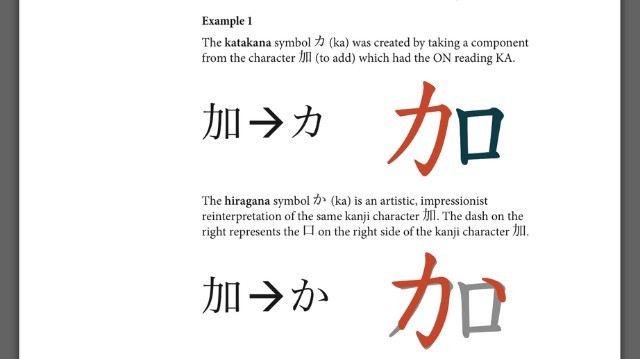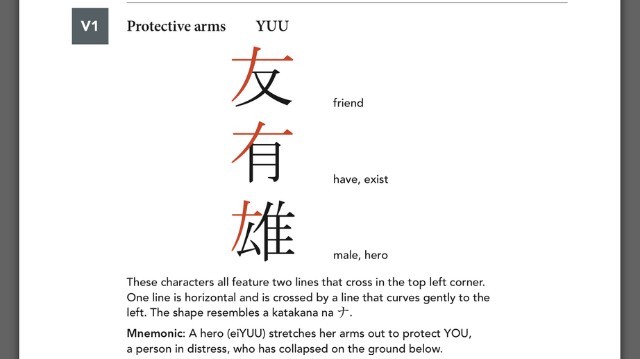I recently bought the Kindle edition of The Kanji Code: See the Sounds with Phonetic Components and Visual Patterns by Natalie Hamilton. So today, I figured that I would write The Kanji Code review and talk about the contents of the book and its approach.
Based off of the title alone, you can probably figure out that the book has something to do with the readings of kanji. If you did so, then you would be correct!
Let’s talk about it now.
The Goal Of The Book
The objective of The Kanji Code is to help you learn and remember the ON-readings of kanji in a systematic and efficient way.
As I’m sure you know, a kanji can have multiple readings depending on which one it is and what context it appears in.
These readings are divided into two categories based on where they come from: the original Japanese language, or borrowed Chinese words.
The original Japanese words are known as the KUN-readings, and the imported Chinese words are called ON-readings.
The KUN-readings are pretty much random, but as it turns out there is actually a logic to the ON-readings. This means that if you understand the patterns of the ON-readings then you can greatly reduce the time (and frustration) that it takes to learn them.
I can say that from my own experience learning kanji that these patterns certainly exist and I noticed them after many, many months of reading Japanese articles, novels, and manga.
My journey to realizing this fact, and then using it to my advantage took a long time, was pretty haphazard, and occurred randomly.
The author of this book also noticed these things and took the time to create this book as useful resource for others so that they can have an easier time at it.
This book is a way to learn what these patterns are and remember them so that the reader can boost their kanji reading capabilities.
It’s like throwing gasoline onto the fire of Japanese reading comprehension.
The book is broken down into three sections that teach the ON-readings of kanji:
- The Kana Code
- The Phonetic Code
- The Visual Code
Each one of these approaches uses a different method for remembering the readings of kanji.
Let’s take a look at each one now.
The Kana Code
Out of the three codes, I would have to say that The Kana Code is my favorite. The reason is because of how simple, yet powerful it is.
The first thing that this chapter explains is how hiragana and katakana were actually created from kanji.
Katakana was created by taking a piece of a kanji out, whereas hiragana is a cursive version of an entire kanji.
What that basically means is that we can take our existing knowledge of kana (hiragana and katakana) and use it to identify the ON-readings of particular kanji.
Here’s an example of this now:

As you can see, both the hiragana か and the katakana カ come from the kanji 加.
Since the katakana カ is pronounced “ka” and is a part of the kanji 加 we know that anytime we see 加 used in compound words, it will be read as “ka.”
This is further illustrated in the example words 追加 (tsuika) and 参加 (sanka).
So, in this section of the book you are shown 57 kanji characters with a katakana or hiragana illustration that shows you the correct ON-reading of said kanji.
The reason why I love this method so much is because by the time you start learning kanji, you already know both hiragana and katakana. This means that you can take a shortcut to learning and remembering a lot of ON-readings.
Something else that should be noted about this book is that it does a great job at providing useful information about the Japanese writing system such as the history of kana and kanji, different types of components and their utility, and much more that I enjoyed reading.
The Phonetic Code
The next section is focused on the phonetic components of kanji and how you can leverage that knowledge so that when you learn the reading of one kanji, you’re able to automatically extend it to several more.
This is the method that I noticed on my own when I began to read a lot of different Japanese materials jam packed with kanji.
But whereas I would only notice one or two other kanji that I could extend the ON-reading to, this chapter covers 150 phonetic entries and then provides several kanji for each entry that utilize the phonetic component.
Here’s an example of what I’m talking about:

In this case, the phonetic component also happens to be a kanji. This won’t always be the case, but it’s nice when it is.
At any rate, the ON-reading for the kanji 五 is “go” and once you know that, you can see other kanji that use 五 within them as a radical.
For example, the two kanji 悟 and 語 both have 五 in them and they both use “go” as their ON-reading.
So by learning the reading of one phonetic component, and then seeing where else that component is used, you can effectively learn three kanji readings with roughly the same time and effort it took to learn one.
Think about that for a second.
Now extend that thinking to all 150 phonetic components contained in this section, each of which has several kanji that use the same ON-reading, and you can begin to see the power of using this method.
Not only do you learn and understand the patterns behind ON-readings, but you also see how kanji are connected to one another.
While The Kana Code was my favorite due to its instant usability, I think that The Phonetic Code is much more powerful (and useful) simply due to the sheer number of components and related kanji.
Thankfully it’s not a situation where you have to pick one or the other. You get them both!
Plus this next one.
The Visual Code
The final section is titled The Visual Code and it takes on more of an artistic approach to learning and remembering how to pronounce certain kanji.
The visual patterns are combined with a mnemonic (an association that assists in memory) so that when you see the kanji that contains the pattern, it triggers the mnemonic which reminds you how to read it.
Here’s an example provided in the book:

In this example, the pattern is the two crossed lines in the top left corner of each kanji. Imagine that they represent the two arms of a person.
The mnemonic is the story of a hero holding her arms out to protect you.
Since the Japanese word for hero is pronounced “eiyuu” and the story has the hero protecting you, it’s easy to remember that kanji with this artistic component are read as “yuu.”
That is the general idea with this third section of the book, and although I had never used these kinds of mnemonics to remember the readings of kanji before, I have used them to great effect for remembering a kanji’s meaning.
When I stop to think about it, it makes perfect sense that using these kinds of memory tricks to recall information about a kanji can be effective in recalling its ON-reading as well.
Because of that, I think that this method is a really good one for using the visual cues to assist in remembering information.
Where To Find it
I’ve never actually read a book before that systematically teaches you how to learn and remember the ON-readings of kanji, so I was pretty impressed by both the logic and the intuitiveness of this approach.
The only thing I can say is that I wish I had this book back when I first started learning kanji! I could have avoided a lot of struggle with rote memorization.
Using The Kanji Code saves a lot of time and effort when learning how to read kanji.
It’s the best book I’ve ever read on how to learn ON-readings.
Here where I purchased my copy
Let me know if you have any questions or comments about The Kanji Code. Thanks!
Further Resources for Learning Japanese:
#3 Get My eBook (Secrets to Learning Japanese) for Free

またね!

I often find myself drawn to different elements of unfamiliar cultures. Learning a foreign language is the biggest draw for. From your review, I can clearly understand that kanji are the hardest part of learning the Japanese writing system. Sounds like from your experience that it would take a lot of hours of deliberate practice to learn how to use them. Still, it has been informative, thanks for sharing
Yeah, I think that kanji can take a long time for several reasons. One of them is that there’s simply a lot of them, several thousand that you have to learn in order to be considered literate in the language.
Another reason is just because they function so differently than our Alphabet, so you have to learn a new way of thinking in order to become really good at them. Thankfully there are lots of tools like this book that make the process of learning a lot easier.
I have been interested in learning Japanese for some time, however, it always looked very complicated. This book looks like it does a great job of separating this into different sections so even somebody like myself can follow along and put together the phonetics used to speak Japanese. The different style of writing has confused me before, I think I find that part the most interesting.Thank you for sharing!
Hey Travis, yeah I think that the writing system is one of the reasons why Japanese is considered extremely hard to learn, but like most skills in life it just takes some study and a lot of practice.
Books like these help people make sense of the complexities and get going faster than if they ploughed through without a plan. At least, that’s been my experience.
I have never really heard of using mnemonics to learn Kanji before because I haven’t started just yet on learning the writing of the Japanese language. I do like the Japanese culture. Is Kanji difficult to understand? How long have you been learning?
I think it would be rather difficult to remember what all of the different meanings for each word are.
I’ve been learning for a couple years now. There’s no doubt that kanji are overwhelming at first. There’s just so much information to learn:
-What does it look like?
-How do you write it?
-What are the meanings?
-How do you read it?
It’s one of those thing that you just have to take one piece at a time and eventually you’ve got the whole puzzle completed.
It’s a lot harder if you approach it haphazardly like I originally did. Finding good tools to use and resources that make it easier to remember are a great way to make the whole process easier and a lot more enjoyable.
The Kanji Code is a great book! It covers the 4 different types of kanji: pictographs, indicators, combographs, and meaning-and-sound-borrowers. We wrote a brief article about the four kinds if you’re interested in finding out which kanji fit the bill of each type: https://learnjapanese.best/2019/12/11/the-four-types-of-kanji/
The kanji code really makes learning the readings of kanji fun and easy, and if you are able to work and play with the hiragana and katakana in your imagination, you can start dream-writing them over new kanji you see, so that you can remember the readings long-term by superimposing a phantom of hiragana or katakana letters on the mass of strokes called kanji.
Yeah, I was really impressed with how Natalie used illustrations to show how the kana looked like the kanji in question, which then lead to its correct ON-reading.